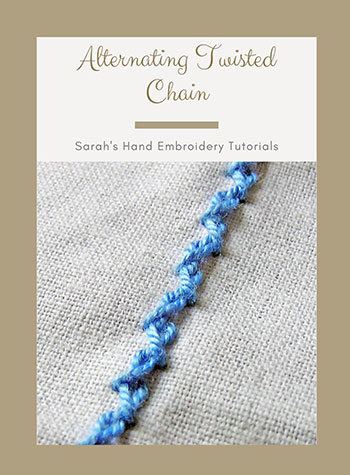
Alternating Twisted Chain Stitch is also known as
Puntada de Cadena Retorcida Alterna [ES], Point de Chaîne Tortillé Alterné [FR], Abwechselnd Gedrehter Kettenstich [DE], Ponto de Corrente Torcido Alternado [PT].
About the Alternating Twisted Chain Stitch
This stitch is a series of twisted chain loops. The difference is that the stitches are placed on the left and right sides alternately. So, the ‘legs’ of the stitches will fall on the left side and the right side of the stitch line alternately. I will follow a straight stitch line to make this lesson clear.
How to do the Alternating Twisted Chain Stitch
To do this stitch, you should be aware of the Twisted Chain Stitch.
 |
 |
| Fig 1: Lay the base by doing a Twisted Chain Stitch. | Fig 2: Now, put the needle in through the right side of the previous stitch and bring it out on the stitch line, as shown. |
 |
 |
| Fig 3: Loop the thread around the needle as illustrated. | Fig 4: When you pull out the needle and tighten the loop, you will get a twisted chain loop with its leg on the right side. |
 |
|
| Fig 5: Continue with this process of making twisted chains. Remember to alternate the sides by taking the needle in on the left side once and the right side the other time. You should get a pattern that looks like the one above. | |
Related Stitches from the Chain Stitch Family
There are plenty more of these Chain Stitch Variations! Please click The Chain Stitch Family to find the entire list!
Learn the stitches from our Hand Embroidery Book
Learn the Alternating Twisted Chain Stitch and 200 other stitches through our 450-page Hand Embroidery book.












 Sarah has been researching and sharing hand embroidery lessons for over 17 years, making it accessible to everyone around the globe.
Sarah has been researching and sharing hand embroidery lessons for over 17 years, making it accessible to everyone around the globe.





Me gustaría aprender las puntadas cordones enlaces de hilo etc para seguir bordándolo
Sure, Maria. Will keep your request in mind. In the meanwhile, there are many stitches that uses threading and lacing over them. Please do check our picture dictionary to locate them: https://www.embroidery.rocksea.org/reference/picture-dictionary/
Thank you.
Thank so much for all the time and effort you have put into these tutorials. I began embroidery at the age of 8. Somewhere along the way I lost interest (too many other crafts) but you have sparked new interest. I have arthritis in my hands and have had to quit some things but I can still hold a needle. Any time I want a certain look and can’t remember how to do the stitch I go here. You are appreciated.
Thank you, Lucy!! It is so heart-warming to hear from you. 🙂
Hello Mam,
What are the different types of needles and threads to be used
for different kinds of fabric (like cotton, synthetic, etc….).
Great stitch. Thanks for sharing this.
Ideal for borders